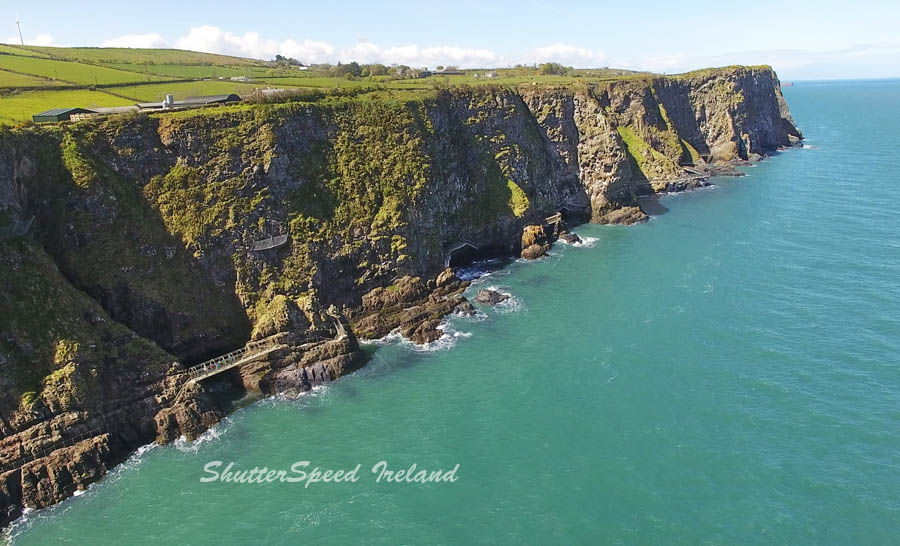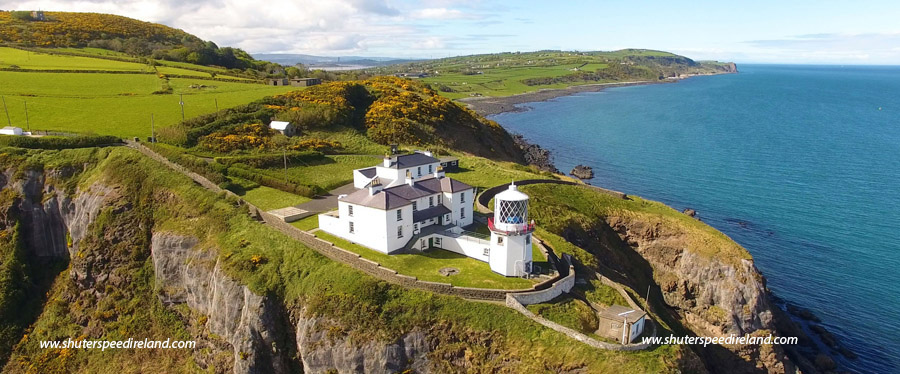The Gobbins Cliff Path
A photographers delight
A sunny day in East Antrim Northern Ireland, is a photographers delight. From Blackhead lighthouse on the edge of Belfast lough, to the colourful dwellings in Whitehead Bay, excites the creative imagination to experiment with such a stunning photogenic landscape.
ShutterSpeed Ireland has a unique selection of the picturesque cliffs and walkways of the East Antrim coastline.
The Gobbins Visitor Centre is open daily. This spectacular location is where you can truly escape everyday life and experience nature in its most fundamental. On a two hour personally guided walking tour you may even feel the sea salt on your lips, experience the Irish Sea wind, marvel at tales of local smugglers, witness the native sea birds and keep your eyes open for some dolphins swimming off the rugged coastline.
The Gobbins experience takes you along a narrow path hugging the dramatic cliff face; across spectacular bridges amid the crashing waves of the North Channel; traversing hidden Tunnels under the Irish Sea; up and down rugged staircases carved into the cliff face and into caves that were once home to smugglers and pirates.
The Gobbins Path is a difficult trek and is narrow and uneven, accessed by a very steep pathway. Due to the nature of the rugged coastal location it is essental to wear suitable clothing and stout walking/hiking boots with thick tread and ankle support. Without exception, all guests must wear a safety helmet whilst experiencing The Gobbins.
Bore caves and natural aquariums
The Gobbins was created by an Irish railway engineer called Berkeley Deane Wise. He designed and built the path as a tourist attraction for the Belfast and Northern Counties Railway Company.
Thousands of people visited The Gobbins in the first few decades of the 20th century.
The Gobbins Cliffs, with its bore caves and natural aquariums has no parallel in Europe as a marine cliff walk’.
Car parking, a café, an exhibition and visitor facilities for The Gobbins are provided by a reception centre at nearby Ballystrudder.
The Gobbins was the brainchild of a pioneering Irish railway engineer called Berkeley Deane Wise. At the age of just 22, he developed tunnels and bridges for one of the most challenging sections in the country, along the coast at Bray Head. This and other experiences helped give Wise the skills he needed to conceive his ultimate achievement The Gobbins just over 25 years later.
In 1888, Wise became the Chief Engineer of the Belfast and Northern Counties Railway Company. The company already had a keen interest in tourism, thanks to the work of another pioneer, Railway Manager, Edward John Cotton one of the youngest ever Railway Managers in Britain and Ireland. Cotton arranged ‘excursion trains’ for every occasion and made 3rd class tickets available from all stations opening up the possibility of travel and day trips for thousands of ordinary people.
Hamlet of Whitehead
Blackhead Lighthouse – Berkeley Deane Wise built bridges and a tunnel to make a path here before he created The Gobbins.
Berkeley Deane Wise took this tourism endeavour to the next level, creating innovative new paid-for attractions that would encourage visitors to use the railway company’s services. Within a year of starting at the ‘Northern Counties’ he had opened a series of paths and bridges at beautiful Glenariff Glen later adding a tearoom and shelters with coloured glass to view the waterfalls there.
Just south of The Gobbins, Wise helped transform the tiny hamlet of Whitehead into a premier holiday resort. He designed and built a bandstand, ladies and gents bathing boxes, a ‘children’s corner’, a slipway and a pavilion with 500 seats.
Spectacular Cliff Section
Berkeley Deane Wise drew up a map of his planned path in 1902, showing a 3 & 1/4 mile long route. It would start near the village of Ballystrudder (a small laneway just off the ‘Gobbins Road’ is still called the ‘Gobbins Path’ as a consequence).
The path would then run for a mile or more along an undulating section of coast, skirting farmer’s fields before reaching the spectacular ‘cliff section’ where visitors would enjoy bridges, tunnels and caves. It is this last section which became so famous and which is accessible today (by guided tour, leaving from The Gobbins visitor centre). Wise’s map listed a series of new names for features along the cliffs, which he planned for visitors to explore – like Sandy Cave, the Man O’War stack and Otter Cave.
The first stretch of The Gobbins opened to the public in August 1902. First to explore its ‘strange, fantastic forms’ were members of the British Association for the Advancement of Science. In June 1904, Wise hosted the Institution of Civil Engineers of Ireland.
The ‘special bridge’ the engineers were describing was the famous Tubular Bridge – which quickly became a symbol of The Gobbins.
When it first opened, the path stopped short of the ‘Seven Sisters’ caves. But Wise’s map shows he planned to continue building to Heddles’ port and create an exit onto to the ‘county’ road. in 1905 he was granted money to extend The Gobbins by the railway company which had become part of the larger Midland Railway Company (MR).

The Gobbins Cliff Path Larne Co Antrim Northern Ireland
Irish Jaunting Car
The Gobbins became a must see for tourists and locals alike – including many visitors from Britain who came via the steamer service to Larne and stayed there or in Whitehead. Tourists could book trips to The Gobbins through their hotel, with each having certain days of the week for visiting with their own guide.
Posters advertising The Gobbins were placed in Belfast tram carriages and at railway stations. Day-trippers were encouraged to travel to Ballycarry railway station for The Gobbins. From there they could walk or hire a local ‘Irish jaunting car’ to get to the path itself.
The entrance to The Gobbins – then as now – was nicknamed Wise’s Eye after the path’s creator. An oval shaped hole bored in the rock, it was manned by a railway company ‘toll collector’ from 10 am to 5 pm daily.
The Gobbins required constant maintenance to cope with the impact of waves and storms. Following the Great Depression and the steady rise of competition from road transport, the railway company got into financial difficulties – by 1938 the Northern Counties Committee was losing £19,000 a year.
Wise’s Eye at The Gobbins
The Gobbins was closed for a time in 1936, then during the Second World War there was an even more acute shortage of manpower and finance. As a result, no upkeep was carried out, apart from painting the railings black to avoid them acting as a landmark for German air-raids heading into Belfast.
After the war, The Gobbins was briefly reopened by the new Ulster Transport Authority, but closed in 1954. Several attempts were made by government and individuals to restore the path. Writer and filmmaker, John H. Lennon from Co Down was a particular champion. However lack of finance and scepticism about tourist numbers in the face of the conflict in Northern Ireland frustrated these attempts.
The first Tubular Bridge finally collapsed into the sea in May 1981.
The remains of the path continued to be explored by climbers and walkers. However the cliffs were dangerous, and several people got into difficulties and had to be rescued during the 1980s, 90s and 2000s.
The new Tubular Bridge being craned into place at The Gobbins.
In 2011, after years of work, Larne Borough Council announced a plan to reopen The Gobbins. A series of 15 new bridges and 6 new gallery structures (which hug the side of the cliff) were constructed and installed during 2014-15. The reimagined path includes an iconic new Tubular Bridge. Weighing over 5.4 tonnes, it was craned into position on 22 October 2014.
Visitors can once again enjoy the 22m-long tunnel, including a section which runs below sea-level. Four of the new bridges are over 30 metres in length. The project has also improved on Wise’s original work with a new cliff top path, which offers views stretching as far as Ailsa Craig in Scotland, and a cantilevered platform and staircase providing viewing points over the first bridges to the north and Belfast Lough to the South.
ShutterSpeed Ireland have a wide selection of enchanting photographs and video footage of The Gobbins and Blackhead Lighthouse plus other attractions in Co. Antrim Northern Ireland
www.shutterspeedIreland.com
Photos and Multimedia of The Gobbins here
Photos and Multimedia of Blackhead Lighthouse here
Ballygally View Images here
Are you visiting The Gobbins? For more information click here
Looking for a tour guide? Shutter speed Ireland can recommend ‘Milliken Tours Ireland’
A professional, family run tour group who will go that extra yard to make your visit to our country fun filled and memorable. Contact them here











